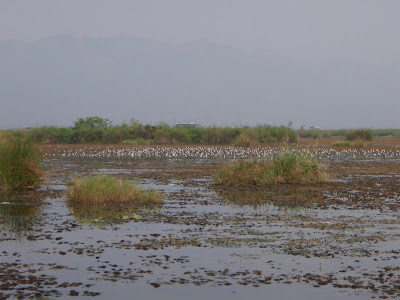Importância da palinologia da Lagoa do Saloio na reconstrução paleoecológica da mata do Valado de Frades
Sandra Gomes
As zonas húmidas como lagoas, turfeiras, pântanos, sapais e outros ecossistemas palustres caracterizam-se pelo seu dinamismo e complexidade do ponto de vista geomorfológico sendo por isso também altamente susceptíveis face a eventuais impactos naturais e/ou antrópicos. A área em estudada, em 2007, a lagoa do Saloio, localizada no concelho da Nazaré, encerra uma história de mudanças ecológicas que se foram sucedendo no decorrer do Holocénico.
Esta “história” evolutiva encontra-se preservada nos sedimentos da lagoa, constituindo a sua análise e posterior interpretação elementos irrefutáveis das alterações ambientais naturais ocorridas quer a nível local quer a nível regional. Mais recentemente, mudanças antrópicas terão causado o seu impacto na área em estudo, sobrepondo-se aos processos naturais. O recurso a diferentes disciplinas viabiliza a possibilidade de vislumbrarmos concertadamente o passado, reconstituindo os acontecimentos patentes nas principais mudanças ecológicas da paisagem. Todavia a palinologia de lagoas e turfeiras, devido à fiabilidade dos seus registos, constitui um dos mais importantes métodos na reconstrução da flora, vegetação e ambientes pretéritos (Faegri e Iversen, 1989).
O Homem, como os demais agentes constituintes da biosfera, é um agente modelador/construtor da paisagem. A sua intervenção reflecte-se de um modo mais ou menos gradativo no território, por vezes irreversivelmente. Assim sendo, o território, pode considerar-se como um artefacto, sendo talhado a cada gesto humano, com repercussões ao nível social (com a repetição do gesto) e ao nível do ecossistema, ao alterá-lo do ponto de vista funcional e espacial no decurso da história e evolução humanas (Mateus et al., 2003).
O concelho da Nazaré apresenta registos de ocupação desde há muito, existindo evidências de ocupação Paleolítica no concelho. No decorrer desta apresentação, procederemos a uma descrição das dinâmicas de ocupação humana na região e seu impacto no ecossistema adjacente, no decorrer do Holocénico recente, assente nos estudos polínicos efectuados. Mais concretamente, desde a colonização dos romanos, cujo impacte na vegetação se revelou intenso, abrangente e diversificado (provavelmente devido à instalação de verdadeiros núcleos urbanos), passando pela Idade Medieval com a atribuição de forais, (o que levou à exploração mais intensificada da região do ponto de vista da silvicultura e da agricultura), cujas evidências estão patentes nas curvas polínicas, até à actualidade




 Aimed at capacity building in the study of pollen grains that have key taxonomic characters, a user-friendly pollen taxa identification method is being developed. In other words, this project highlights the utility of New Tools for "Learning Palynology by click of the mouse" by Taxonomists, promising young Palynologists and Paleo-environmentalists and others (in Paleo- and Neo- Tropics) trained in light microscopic techniques.
Aimed at capacity building in the study of pollen grains that have key taxonomic characters, a user-friendly pollen taxa identification method is being developed. In other words, this project highlights the utility of New Tools for "Learning Palynology by click of the mouse" by Taxonomists, promising young Palynologists and Paleo-environmentalists and others (in Paleo- and Neo- Tropics) trained in light microscopic techniques. Chemically fossilised/acetolysed tree pollen taxa of 153 species belonging to 147 genera (Mangroves: 11, Western Ghats: 129 and others: 7) and 63 families (2 monocots and 61 dicots) have been included. The pollen slides are from the pollen-spores slide collection (22,000 specimens in a database furnishing taxonomic information, the richest in Asia) of the Palynology Laboratory of the French Institute of Pondicherry.
Chemically fossilised/acetolysed tree pollen taxa of 153 species belonging to 147 genera (Mangroves: 11, Western Ghats: 129 and others: 7) and 63 families (2 monocots and 61 dicots) have been included. The pollen slides are from the pollen-spores slide collection (22,000 specimens in a database furnishing taxonomic information, the richest in Asia) of the Palynology Laboratory of the French Institute of Pondicherry.












